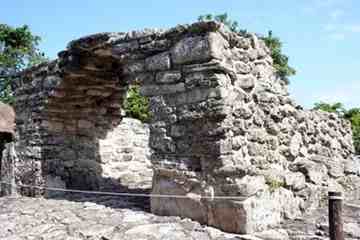While most of our fellow cruise ship tourists elected to head to the Cozumel, Mexico, beaches for sun, snorkeling and swimming, my travel companion, Jan Baxter of Ocean Springs, and I decided to visit the island's Mayan Ruins at San Gervasio, located 7 miles east of San Miguel.
 Accompanied by a knowledgeable tour guide and Mayan descendant named Alex, we and 82 other "cruisers" on Oct. 16 made a half-hour bus trip from San Miguel to the holy site, dedicated to Ixchel, the goddess of fertility. We learned that San Gervasio is the largest of the Mayan Ruins on Cozumel, and a holy site.
Accompanied by a knowledgeable tour guide and Mayan descendant named Alex, we and 82 other "cruisers" on Oct. 16 made a half-hour bus trip from San Miguel to the holy site, dedicated to Ixchel, the goddess of fertility. We learned that San Gervasio is the largest of the Mayan Ruins on Cozumel, and a holy site.
Mayan women would pilgrimage here from all over the country to pray at its temples to insure an abundance of offspring. The village settlement dates back as far as 100 B.C., and was continually settled starting in 200 A.D. Several temples still stand today, and while small compared to the massive ruins sites in the Riviera Maya, we found it was well worth the visit.
Baxter noted that since her visit to these same ruins two years ago, many improvements have been made, with the addition of sidewalks for better accessibility.
"We were walking in the mud on my last visit," she said.
Even today, one needs to be sure-footed to walk the ruins that are set in the Mayan jungle, draped in rain forest and frequently inhabited by iguanas. Sidewalks are stony and the terrain uneven. We were fortunate to have picture-perfect weather, and were actually greeted by a couple of iguanas that were not at all shy of us.
Alex informed us we were only seeing about one-fourth of the site. Future plans are to excavate, develop and open up the remaining area.
"Funds have not been made available to complete the work," he said.
The Mayan calendar is just one example of the advanced development of the Mayan civilization.
"It has been found to be within a tiny fraction of a second match to NASA's scientific measure of time, Alex told us.
Dispelling the notion that because the Mayan calendar ends in 2012 that would mark the end of the world, he said, "The 2012 date is the end of a calendar cycle and the Mayans did not say that this would be the end of the world."
Alex counts himself as proof that the Mayans as people are not extinct.
"The civilization is gone," he said, "but Mayan descendants live on."
He described distinctive physical characteristics of the Mayans.
"Archaeologists believe the Mayans may have come from as far as Mongolia," he said. "We have Mongolian features, are small in stature and many of us have a mark in common on our lower backs."
San Gervasio was already abandoned when the Spanish explorers discovered it. Alex surmises an extended drought probably put the agriculture-dependent village in exodus, and disease spread by prior explorers took a toll.
This tour made me want to see more of the Mayan Ruins and study the rise and fall of the Mayan culture and civilization.
Author: Jo Andy | Source: Gulf Live [October 24, 2010]